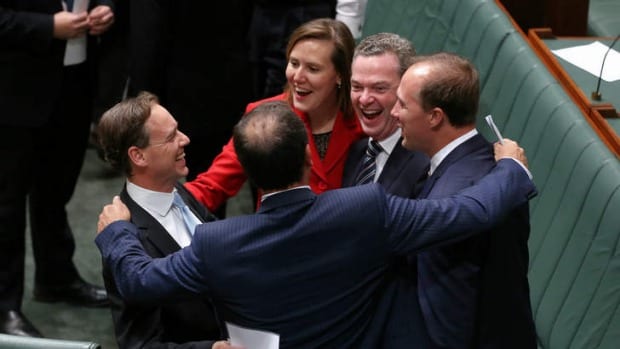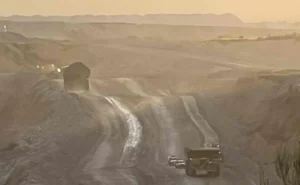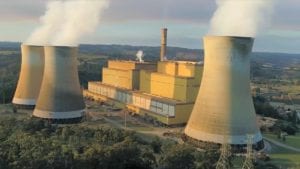They say that in space, they can’t hear you scream. Chief scientist Alan Finkel has been trying to explain, as loudly and forcefully as he can, that wind and solar are the cheapest form of new energy. But in the Coalition, they can’t hear you scream that particular message.
It is now more than a week since the Finkel Review was unveiled – to a mix of hope, promise, disappointment and frustration. But judging by the rhetoric of the past few days, it has failed even in its most basic tests: to move the debate forward and to promote acceptance of the obvious, that new renewables are cheaper than new fossil fuels.
So much so that the review, which has been hailed as a “once in a generation” opportunity to bring Australia’s ailing energy market into the 21st Century, is now being used as an excuse to take it back to the 19th.
Despite pleading from business, the Coalition hasn’t changed its stripes at all. They are still calling for new brown coal generators in Victoria, and a new black coal generator in north Queensland.
Queensland LNP leader Tim Nicholls has promised to set the wheels in motion for new coal-fired generation in Queensland’s north “within 100 days” of winning office, and federal energy minister Josh Frydenberg has slipped back into his pre-Finkel rhetoric of blaming the states for all of the NEM’s woes.
Deputy prime minister and CLIF (chicken little in chief) Barnaby Joyce, he of the $100 roasts (remember his criticism of the carbon price), was wondering where electricity would come from if there was no coal power.
He told the ABC Insiders program on Sunday that lights would go out and TV screens would go dark.
“I flew in this morning Barrie, it was a beautiful day, not a puff of wind and if memory serves me correct, it was dark last night, so you switched off your coal-fired power stations, how do you switch on the lights?” he said, before adding: “So it’s just, we’re living in a different church to reality.”
You bet we are. And what did Australians do to merit such idiocy?
The Finkel Review makes it clear that the building of new coal-fired power stations offers neither cheaper power nor greater security.
And Finkel’s is a conservative approach: despite hailing the “unstoppable” energy revolution in his draft report, Finkel barely touches on the radical transformation that the CSIRO and the network owners said was not just possible, but absolutely essential in the name of grid security, and to manage costs.
There are no coal-fired power stations still operating by 2050 envisaged in the CSIRO report. In fact, the grid is decarbonised well before then, more than two decades before the deadline contemplated by Finkel, and with savings of $100 billion.
The difference between Finkel and CSIRO is that when the CSIRO consulted, they were focused on the future, what needed to be done, and then rowed back. “We said that if anyone just wanted to talk about 2017, they should probably leave the room,” said one participant.
What the Coalition fails to grasp is that the Finkel review recommendations and the “clean energy target” – combined with mandatory storage for new wind and solar farms, and a trading scheme that leaves the mechanism in the hands of the coal station owners – are probably the best defence for the coal industry that could be mustered.
That’s because the Finkel Review does not contemplate the “well-below” 2°C targets Australia signed up for in Paris, does not impose a tax on existing generators, and will allow highest level of coal generation by 2050 of any scenario it modelled, and much more than “business than usual.”
But the Coalition is being blinded by their own prejudices, and misled by the likes of Brian Fisher, the former ABARE chief who is a notorious critic of carbon policies and renewable energy, and who has prepared numerous reports for the Minerals Council of Australia.
Fisher is trying to convince the Coalition that the Jacob’s modelling “underestimates” the cost of wind and solar, and is being quoted widely in the Murdoch media and elsewhere.
If anything, the Finkel modelling, like so much before it, seriously over-estimates the cost of wind and solar – a fact acknowledged by Finkel himself and reinforced by real life contracts and the latest assessment of energy costs by Bloomberg New Energy Finance.
Finkel argued – post modelling – that wind and solar, even with storage and “firming capacity,” are cheaper than gas and on a par with coal. BNEF goes further, making the point that wind and solar are far cheaper than coal, and soon will be even cheaper than the cost of refurbished coal-fired generators pushed beyond their 50 year life.
Finkel bristles at the idea that his review was a political document rather than a scientific or engineering one, and at suggestions that he was “leaned on” or that he “self-edited” the report to help break the political impasse that has blighted the energy and climate debate for a decade or more.
But the review is in stark contrast to that report prepared by the CSIRO, which not only runs with the “unstoppable” transition scenario, but shows the path to reach decarbonised energy for much cheaper and at a faster pace than Finkel.
By 2050, the CSIRO notes, around half of all electricity is provided by local generation. All large-scale generation is renewable. The likes of Transgrid have run similar scenarios, as have BNEF, and numerous academic studies.
Finkel, on the other hand, relies on Jacobs modelling that assumes that the only replacement for coal generation can be gas, and ignores the technologies – battery storage, pumped hydro, and other storage – that could fill that void at a fraction of the price.
Where does this leave us? At least one political party short of rational thought.
The Finkel recommendations have much to be admired, or at least discussed in a reasonable light: notably its advice on market governance, grid management and grid security and the need for storage. And for some sort of mechanism.
There is much debate to be had about whether the likes of the Australian Energy Market Commission should be trusted to manage rule changes and implement them in the same decade that technological change demands it, whether each new wind and solar farm needs new storage, whether gas is the only option for back-up power and firming, whether the CET should be managed through auctions or left in the hands of the gen-tailers who buggered up the RET.
And there has been criticism from outside about its failure to embrace distributed energy – a critical point, given that solar and storage are going to offer consumers a cheaper alternative to grid power – and the lack of focus on energy efficiency.
But it offered a way forward. And yet here we are, again reduced to absurdist arguments about the lights going out.
It leaves Australia with the ridiculous prospect that the far right will continue to dictate the rules to be followed for the market, just as they have done for most of the past decade. In effect, a grid designed by idiots. This is not Grid 2.0.












